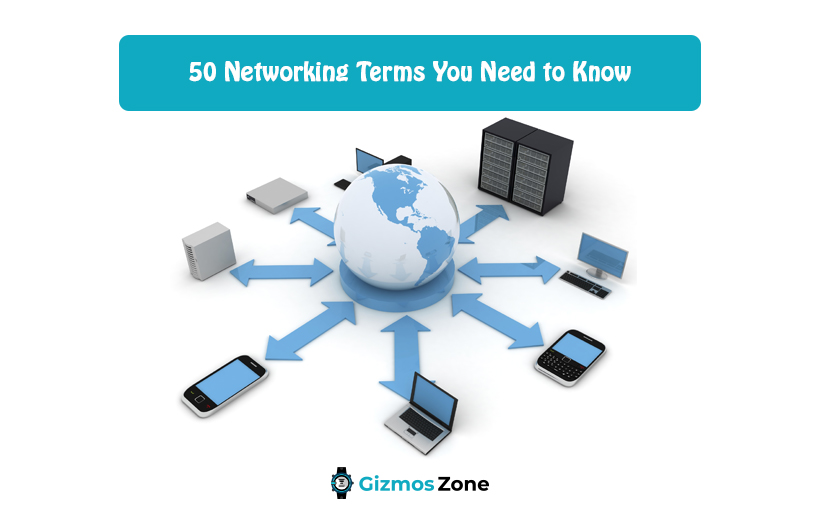Networking is the process to interconnect multiple devices for information processing and communication. The network helps the individuals to connect with the wider world and more importantly, it helps the people to enhance their performance. If you are not so well-equipped with the networking terms then, do not worry! All the necessary networking terms that you should be well aware of have been highlighted below for your reference. So, continue reading the post further to enhance your knowledge and sharpen your skills for betterment.

- Address Resolution: Address Resolution is a support function that helps to support the network devices in matching the physical location of a device to the known address.
- DHCP: This is a device that aids the users to get the logical address as well as the configuration information of a device over the network.
- BOOTP: BOOTP is also similar to DHCP in terms of providing the logical IP address of a device. However, they are not completely similar to one another.
- Frame: Well, the frame is a concept that carries the packets to the ultimate destination from a source. It helps to find out the next destination address.
- LAN: LAN or local area network as the name suggests is an internet of a local area. LAN has a lot of fault tolerance as well.
- WAN: The term WAN refers to the wide-area network. It covers a wide area as compared to LAN and has lesser fault tolerance.
- Protocol: The term protocol refers to the rules and regulations that have been enlisted and should be followed by the users.
- Routing Table: Every router, follows the rules as per the routing protocols and then, builds a routing table of the logical area address and logical network.
- Subnet: The next networking term is the subnet. This refers to the logical group of multiple devices that are connected with a single network.
- TCP/IP: IP/TCP as could be understood by the very term refers to the Internet protocol/ Transmission Control Protocol. These are the rules and regulations for the network that has to be followed.
- Broadband: It is a type of internet connection that offers high speed and is considered as the standard and the most common method to connect to the internet connection.
- Bandwidth: As far as the meaning of the networking term bandwidth is concerned, it refers to the capacity of the information that your network could carry.
- Cat6: The Cat6 refers to the category 6 cable that helps the users to get the highest speed of the internet connection. It is much faster as compared to the Cat5 cable.
- Cat5: Well, similar to the Cat6 cable, Cat5 refers to category 5 that aids in connecting multiple devices to the internet connection.
- Ethernet: Ethernet is a traditional technology that is used to connect the router to your device to avail the internet services.
- Network Switch: The network switch is in layman’s terms referring to the switch that helps to connect multiple devices to your local area network.
- Router: Router is the internet service providing technology that is used widely throughout the world. It connects your device with the main source of the internet.
- Wireless Access Point: The wireless access point is the point that helps to connect various devices through the radio-frequency waves without any need for a port.
- IP address: IP address is the address of the device that you are using. Your device has an IP address and that could be tracked through the IP address number.
- ISP: The networking term ISP refers to Internet Service providers. The source or the organization that provides the network is the Internet Service Provider.
- Latency: The term latency refers to the delay between your action or command and the response to it by your system. The more delayed response your system gives higher is the latency.
- Ping: Pings is the lag that one gets to experience due to the slow speed of the internet connection. If the speed of your internet is low then, it tends to ping.
- WISP: Wireless Internet Service Providers as the term suggests is the internet service provider that provides internet wirelessly. It is similar to ISP and the only difference is that this is wireless.
- WLAN: The WLAN is also termed a Wireless local area network. It refers to the internet connection or network of a particular area only.
- WPAN: As could be understood with the very term, it is the wireless personal area network that allows the network to be transmitted between the personal devices.
- WPS: Well, WPS is also referred to as Wi-Fi Protected Setup. This helps establish as well as protect the connection between your device and the network.
- Wireless: The terms wireless means that the device you are using will not require any wire to get connected to another device.
- Wired devices: Wired devices are those devices that can be connected with other devices only with the help of wires or ports.
- Wireless adapter: An adapter is a device that helps to connect your computer with the router. When this adapter is connected to your computer wirelessly, it is termed a wireless adapter.
- Wi-Fi: It refers to a wireless network that helps to connect multiple devices to a single network without any wires or ports.
- Web Server: The term web server refers to the computer or a group of computers that deliver web pages to multiple users.
- Webcast: Well, the networking term webcast refers to delivering the set of information to all the network users at a time.
- User: It is a very simple term, yet to provide clarification, the term user refers to the individuals using the services provided by the network.
- User account: The user account refers to the account of the internet service user. It refers o the location or an address through which the information is accessed.
- User name: The user name on the other side is the name of the device through which the information has been taken out.
- Upload: The term upload means when the individuals share his/her file on the network with others, they have to upload the file.
- Traffic: Traffic in the networking language refers to the congestion in the communication between the device and the network.
- Traffic rate: The term traffic rate will refer to the rate of the traffic or the transmission speed. This refers to the time taken by the files to be transmitted.
- Spanning Tree Protocol: Spanning Tree Protocol refers to the networking device that helps to create the same path to avoid loops or trafficking.
- Remote user: Well, the term remote user refers to the situation when the user is using the network on their computer at some other location at random.
- Remote access: It refers to remote access to the network or the internet connection. The user can use the resources of that network for a while.
- Permission: As you can understand with the very term, it is the access details that the administrator controls. They may or may not provide access or permission to other devices.
- Log off: When the user is trying to disconnect from the network then, it is referred to as logging off or signing off.
- Log on: In case, you are trying to connect to the network and hence join the network, it will be known as logging in or signing in the networking language.
- Intranet: Just like the term internet, an intranet is a networking service that helps people to get digital. But, an intranet is more reserved and private as the only device that has access can be used to avail the internet services.
- File transfer: The term file transfer refers to transferring the different files and documents to another location or another device.
- File sharing: The file-sharing is different from file transferring. Here, you try to share your file with others through different mediums.
- Flood: The term flood refers to a situation where your devices get overloaded with different files and documents. Hence, you refer to that situation as flooding.
- Data transfer: When you transfer any data from one location to another, it is referred to as data transfer. It can be files, folders, and even documents.
- Cable: It is a technological device that helps to connect different devices. This cable is extremely crucial in the technical world.

Conclusion
These were a few of the networking terms that are very critical for you to know about. These terms are very commonly used in the networking world. They are used in the day to day life and hence knowing them is very critical for the users. Go through these terms to have a basic understanding of the networking world. So, even if you are not a technology lover person, these are the terms you should know of for your knowledge enhancement. Try to remember these terms so that you do not feel embarrassed in front of people for not knowing the very simple and basic terms.
